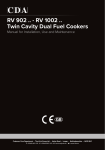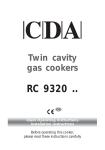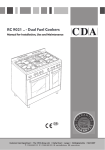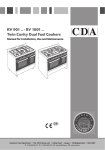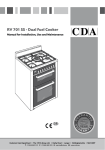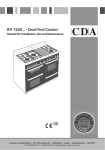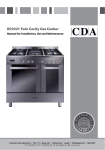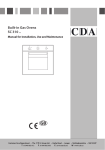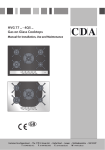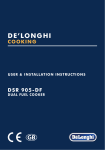Download CDA RC 9322 Technical data
Transcript
RC 9322 .. Twin Cavity Gas Cooker Manual for Installation, Use and Maintenance GB Customer Care Department • The Group Ltd. • Harby Road • Langar • Nottinghamshire • NG13 9HY T : 01949 862 012 F : 01949 862 003 E : [email protected] W : www.cda.eu Important This appliance is designed and manufactured solely for the cooking of domestic (household) food and is not suitable for any non domestic application and therefore should not be used in a commercial environment. The appliance guarantee will be void if the appliance is used within a non domestic environment i.e. a semi commercial, commercial or communal environment. The CDA Group Ltd cannot be held responsible for injuries or losses caused by incorrect use or installation of this product. Please note that CDA reserve the right to invalidate the guarantee supplied with this product following incorrect installation or misuse of the appliance. Appliance Information: Please enter the details on the appliance rating plate below for reference, to assist CDA Customer Care in the event of a fault with your appliance and to register your appliance for guarantee purposes. Appliance Model Serial Number Declaration of CE Conformity This cooker has been designed, constructed and marketed in compliance with: • Safety requirements of EU Directive “Gas” 2009/142/EC; • Safety requirements of EU Directive “Low Voltage” 2006/95/EC; • Protection requirements of EU Directive “EMC” 2004/108/EC; • Requirements of EU Directive 93/68/EEC. Important Information for Correct Disposal of the Product in Accordance with EC Directive 2002/96/EC. At the end of its working life, the product must not be disposed of as urban waste. It must be taken to a special local authority differentiated waste collection centre or to a dealer providing this service. Disposing of a household appliance separately avoids possible negative consequences for the environment and health deriving from inappropriate disposal and enables the constituent materials to be recovered to obtain significant savings in energy and resources. As a reminder of the need to dispose of household appliances separately, the product is marked with a crossed-out wheeled dustbin. 2 IMPORTANT SAFETY PRECAUTIONS AND RECOMMENDATIONS IMPORTANT: This appliance is designed and manufactured solely for the cooking of domestic (household) food and is not suitable for any non domestic application and therefore should not be used in a commercial environment. The appliance guarantee will be void if the appliance is used within a non domestic environment i.e. a semi commercial, commercial or communal environment. Read the instructions carefully before installing and using the appliance. • After having unpacked the appliance, check to ensure that it is not damaged and that the oven door closes correctly. In case of doubt, do not use it and consult your supplier or a professionally qualified technician. • Packing elements (i.e. plastic bags, polystyrene foam, nails, packing straps, etc.) should not be left around within easy reach of children, as these may cause serious injuries. • Some appliances are supplied with a protective film on steel and aluminium parts. This film must be removed before using the appliance. • IMPORTANT: The use of suitable protective clothing/gloves is recommended when handling or cleaning this appliance. • Do not attempt to modify the technical characteristics of the appliance as this may become dangerous to use. The manufacturer declines all responsibility for any inconvenience resulting from the inobservance of this condition. • CAUTION: this appIiance must only be installed in a permanently ventilated room in compliance with the applicable regulations. • Do not operate your appliance by means of an external timer or separate remote-control system. • Do not carry out cleaning or maintenance operations on the appliance without having previously disconnected it from the electric power supply. • WARNING: Ensure that the appliance is switched off before replacing the oven lamp to avoid the possibility of electric shock. 3 • Do not use a steam cleaner because the moisture can get into the appliance thus make it unsafe. • Do not touch the appliance with wet or damp hands (or feet). • Do not use the appliance whilst in barefoot. • If you should decide not to use this appliance any longer (or decide to substitute another model), before disposing of it, it is recommended that it be made inoperative in an appropriate manner in accordance to health and environmental protection regulations, ensuring in particular that all potentially hazardous parts be made harmless, especially in relation to children who could play with unused appliances. • The various components of the appliance are recyclable. Dispose of them in accordance with the regulations in force in your country. If the appliance is to be scrapped, remove the power cord. • After use, ensure that the knobs are in the off position. • Children less than 8 years of age shall be kept away unless continuously supervised. • This appliance can be used by children aged from 8 years and above and persons with reduced physical, sensory or mental capabilities or lack of experience and knowledge if they have been given supervision or instruction concerning use of the appliance in a safe way and understand the hazards involved. Children shall not play with the appliance. Cleaning and user maintenance shall not be made by children without supervision. • The manufacturer declines all liability for injury to persons or damage to property caused by incorrect or improper use of the appliance. • WARNING: During use the appliance and its accessible parts become hot; they remain hot for some time after use. –– Care should be taken to avoid touching heating elements (on the hob and inside the oven). –– The door is hot, use the handle. –– To avoid burns and scalds, young children should be kept away. • Make sure that electrical cables connecting other appliances in the proximity of the cooker cannot come into contact with the hob or become entrapped in the oven door. • WARNING: Unattended cooking on a hob with fat or oil can be dangerous and may result in fire. NEVER try to extinguish a fire with water, but switch off the appliance and then cover flame e.g. with a lid or a fire blanket. 4 • WARNING: Danger of fire: do not store items on the cooking surfaces. • WARNING: When correctly installed, your product meets all safety requirements laid down for this type of product category. However special care should be taken around the rear or the underneath of the appliance as these areas are not designed or intended to be touched and may contain sharp or rough edges, that may cause injury. • FIRST USE OF THE OVEN - it is advised to follow these instructions: –– Furnish the interior of the oven as described in the chapter “CLEANING AND MAINTENANCE”. –– Switch on the empty oven on max to eliminate grease from the heating elements. –– Disconnect the appliance from the electrical power supply, let the oven cool down and clean the interior of the oven with a cloth soaked in water and neutral detergent; then dry carefully. • CAUTION: Do not use harsh abrasive cleaners or sharp metal scrapers to clean the oven door glass since they can scratch the surface, which may result in shattering of the glass. • Do not line the oven walls with aluminium foil. Do not place baking trays or the drip tray on the base of the oven chamber. • FIRE RISK! Do not store flammable material in the oven or in the storage compartment. • Always use oven gloves when removing the shelves and food trays from the oven whilst hot. • Do not hang towels, dishcloths or other items on the appliance or its handle – as this could be a fire hazard. • Clean the oven regularly and do not allow fat or oils to build up in the oven base or tray. Remove spillages as soon as they occur. • Do not stand on the cooker or on the open oven door. • Always stand back from the appliance when opening the oven door to allow steam and hot air to escape before removing the food. • SAFE FOOD HANDLING: Leave food in the oven for as short a time as possible before and after cooking. This is to avoid contamination by organisms which may cause food poisoning. Take particular care during warmer weather. • WARNING: Take care NOT to lift the cooker by the door handle. 5 Features and Technical Data 2 4 3 1 2 1 Right Gas oven Fig. 1 Left Gas oven GAS BURNERS 1. Auxiliary burner (A) 1,00 kW 2. Semi-rapid burner (SR) 1,75 kW 3. Rapid burner (R) 3,00 kW 4. Triple-ring burner (TR) 3,50 kW Important Notes: –– –– 6 The electric ignition is incorporated in the knobs. The appliance has a safety valve system fitted, the flow of gas will be stopped if and when the flame should accidentally go out. Control Panel Fig. 2 1 2 3 4 5 6 7 8 9 10 11 Controls Description 1. Left gas oven/gas grill control knob 2. Left oven light control knob 3. Minute counter 4. Right oven rotisserie / light control knob 5. Front left burner control knob 6. Rear left burner control knob 7. Front central burner control knob 8. Rear central burner control knob 9. Rear right burner control knob 10. Front right burner control knob 11. Right gas oven/gas grill control knob 7 Minute Counter Minute Counter The minute counter is a timed acoustic warning device which can be set for a maximum of 60 minutes. The knob (Fig. 3) must be rotated clockwise as far as the 60 minute position and then set to the required time by rotating it anticlockwise. IMPORTANT WARNING: This is only a mechanical timer. Remember to turn off the oven/grill manually. Fig. 3 8 How to Use the Hob Burners Hob Burners Each hob burner is controlled by a separate gas valve operated by a control knob (fig. 4) which has 3 positions marked on the control panel, these are: – Symbol : Tap closed (burner off ) – Symbol : High (maximum) – Symbol : Low (minimum) Push in and turn the knob anti-clockwise to the selected position. The maximum aperture position permits rapid boiling of liquids, whereas the minimum aperture position allows slower warming of food or maintaining boiling condi- Fig. 4 tions of liquids. To reduce the gas flow to minimum, rotate the knob further anticlockwise to point the indicator towards the small flame symbol. Other intermediate operating adjustments can be achieved by positioning the indicator between the maximum and minimum aperture positions, not between the maximum aperture and closed positions. Note: When the hob is not being used, set the gas knobs to their closed positions and also close the cock valve on the gas bottle or the main gas supply line. Lighting of the Hob Burners To ignite the burner, the following instructions are to be followed: 1. Press in the corresponding knob and turn counter-clockwise to the full flame position marked by the symbol (fig. 4) and hold the knob in until the flame has been lit. In the case of a mains failure light the burner with a match or lighted taper. 2. Wait about ten seconds after the gas lighting before releasing the knob (starting time for the valve). 3. Adjust the gas valve to the desired power. Important If the burner flame should go out for some reason, the safety valve will automatically stop the gas flow. To re-light the burner, return the knob to the closed position, wait for at least 1 minute and then repeat the lighting procedure. If your local gas supply makes it difficult to light the burner with the knob set to maximum, set the knob to minimum and repeat the operation. 9 Choice of Burner The burner must be choosen according to the diameter of the pans and energy required. Saucepans with handles which are excessively heavy, in relationship to the weight of the pan, are safer as they are less likely to tip. Pans which are positioned centrally on burners are more stable than those which are offset. It is far safer to position the pan handles in such a way that they cannot be accidentally knocked. Fig. 5 When deep fat frying fill the pan only one third full of oil. DO NOT cover the pan with a lid and DO NOT leave the pan unattended. In the unfortunate event of a fire, leave the pan where it is and turn off all controls. Place a damp cloth or correct fitting lid over the pan to smother the flames. DO NOT use water on the fire. Leave the pan to cool for at least 30 minutes. Do not use pans with concave or convex bases Burner Size Minimum Pan Diameter (cm) Maximum Pan Diameter (cm) Auxiliary 12 14 Semi-Rapid 16 24 Rapid 24 26 Triple Ring 26 Wok 10 28 max 36 cm CORRECT USE OF TRIPLE-RING BURNER • Flat-bottomed pans are to be placed directly onto the pan-support. • To use the WOK, you must place the wok stand in the CORRECT position as shown in figs. 6 - 7. IMPORTANT The special grille for wok pans (fig. 7) MUST BE PLACED ONLY over the pan-rest for the triple-ring burner. CORRECT WRONG Fig. 6 Fig. 7 11 How to use the gas oven (left oven) General Features The oven is furnished completely clean; it is advisable, however, upon first use, to turn ) to eliminate possible traces the oven on to the maximum temperature (position of grease from the oven burner. The same operation should be followed for grill burner. The gas oven is provided with two burners: a. Oven burner, mounted on the lower part of the oven (wattage: 3,70 kW) b. Grill burner, mounted on the upper part of the oven (wattage: 2,50 kW). Attention: The oven door becomes very hot during operation. Keep children away. WARNING: The door is hot, use the handle. Oven burner It carries out normal “oven cooking”. The gas flow to the burner is regulated by a thermostat which allow to maintain the oven temperature constant. The control of the temperature is assured by a thermostatic probe positioned inside the oven. The probe must be always kept in its housing, in a clean condition, as an incorrect position or encrustment may cause an alteration in the control of the temperature. Oven thermostat The oven thermostat (fig. 8) is marked with numbers, these correspond to the oven temperature, in addition the “OFF” position is shown by the symbol . To choose the required oven temperature, turn the control knob until its line mark is level with the temperature required on the control panel (fascia). Fig. 7 Fig. 8 12 Lighting the oven gas burner The thermostat allows the automatic control of the temperature. The gas delivery to the oven burner is controlled by a two way thermostatic tap (oven and grill burners) with flame-failure device. To light the oven burner operate as follow: 1. Open the oven door WARNING: Risk of explosion! The oven door must be open during this operation. 2. Lightly press and turn the thermostat knob anti-clockwise to max position “ 3. Press the knob right down to prime the electric ignition. In case of power cut, press the knob and immediately approach a lighted match to the opening “A” (fig. 9). Never continue this operation for more than 15 seconds. If the burner has still not ignited, wait for about 1 minute prior to repeating the ignition. 4. Wait about 10/15 seconds after the burner lighting before releasing the knob (time of priming of the valve). 5. Close the oven door slowly and adjust the burner according to the power required. ” (fig. 10). Should the flame of the burner extinguish for any reason, the safety valve will cut off automatically the gas flow to the tap. To re-start operation, turn the knob to the “ ” OFF position, wait for at least 1 minute and repeat operations as explained above. Oven cooking For efficient oven preheating, we recommend that grill trays and racks are removed from the oven and replaced after about 15 minutes. Before introducing the food, preheat the oven to the desired temperature. For a correct preheating operation, it is advisable to remove the tray from the oven and introduce it together with the food, when the oven has reached the desired temperature. Check the cooking time and turn off the oven 5 minutes before the theoretical time to recuperate the stored heat. A Fig. 9 Fig. 10 13 How to use the gas grill (left oven) Lighting the grill gas burner The grill burner generates the infra-red rays for grilling. To light the grill burner operate as follow: 1. Open the oven door. WARNING: Risk of explosion! The oven door must be open during this operation. 2. Lightly press and turn the thermostat knob clockwise to the 11). 3. Press the knob right down to prime the electric ignition. In case of power cut, press the knob and put a lighted match to the right and left side of the burner (fig. 12). Never continue this operation for more than 15 seconds. If the burner has still not ignited, wait for about 1 minute prior to repeating the ignition. position (fig. 4. Wait about 10/15 seconds after the burner lighting before releasing the knob (time of priming of the valve). 5. Half-close the oven door slowly. Should the flame of the burner extinguish for any reason, the safety valve will cut off automatically the gas flow to the tap. To re-start operation, turn the knob to the “ ” OFF position, wait for at least 1 minute and repeat operations as explained above. Fig. 11 14 Fig. 12 Do not grill with oven door closed. Always fit the heat shield supplied with the cooker under the front panel before commencing operations (Fig. 14). WARNING. The heat shield and the oven door reaches a very high temperature whilst in use. Keep children away and allow to cool before removing. Use of the grill Very important: the grill must always be used with the oven door slightly open and with shield “A” mounted (Fig. 14). Mount shield “A” which serves to protect the control panel from the heat. Turn on the grill, as explained in the preceding paragraphs and let the oven preheat for about 5 minutes with the door ajar. Introduce the food to be cooked, positioning the rack as close to the grill as possible. The dripping pan should be placed under the rack to catch the cooking juices and fats. A Note: It is recommended that you do not grill for longer than 30 minutes at any one time. Fig. 14 T HO Attention: the oven door becomes very hot during operation. Keep children away. IMPORTANT WARNING For best results when using the grill, place the shelf on the second level and when using the grill pan handle avoid contact with the heat shield which will be HOT during use Oven light NE ZO Notes: • The grill burner has only one setting, which is fully on. • It is important that the heat shield is fitted the correct way up, as shown in the figure 14. The cooker is equipped with a light that illuminates the oven to enable visual checks on the food that is cooking. This light is controlled by a control knob (Fig. 13 position). Fig. 13 15 How to use the gas oven (right oven) General features The oven is furnished completely clean; it is advisable, however, upon first use, to turn the oven on to the maximum temperature (position ) to eliminate possible traces of grease from the oven burner. The same operation should be followed for grill burner. Attention: the oven door becomes very hot during operation. Keep children away. The gas oven is provided with two burners: a. Oven burner, mounted on the lower part of the oven (wattage: 2,20 kW) b. Grill burner, mounted on the upper part of the oven (wattage: 2,00 kW). Oven burner It carries out normal “oven cooking”. The gas flow to the burner is regulated by a thermostat which allow to maintain the oven temperature constant. The control of the temperature is assured by a thermostatic probe positioned inside the oven. The probe must be always kept in its housing, in a clean condition, as an incorrect position or encrustment may cause an alteration in the control of the temperature. WARNING: The door is hot, use the handle. Oven thermostat The oven thermostat (fig. 15) is marked with numbers, these correspond to the oven temperature, in addition the “OFF” position is shown by the symbol . To choose the required oven temperature, turn the control knob until its line mark is level with the temperature required on the control panel (facia). Fig. 15 16 Lighting the oven gas burner The thermostat allows the automatic control of the temperature. The gas delivery to the oven burner is controlled by a two way thermostatic tap (oven and grill burners) with flame-failure device. To light the oven burner operate as follows: 1. Open the oven door WARNING: Risk of explosion! The oven door must be open during this operation. 2. Lightly press and turn the thermostat knob anti-clockwise to max position “ 3. Press the knob right down to prime the electric ignition. In case of power cut, press the knob and immediately approach a lighted match to the opening “F” (fig. 16). Never continue this operation for more than 15 seconds. If the burner has still not ignited, wait for about 1 minute prior to repeating the ignition. 4. Wait about 10/15 seconds after the burner lighting before releasing the knob (time of priming of the valve). 5. Close the oven door slowly and adjust the burner according to the power required. ” (fig. 17). Should the flame of the burner extinguish for any reason, the safety valve will cut off automatically the gas flow to the tap. To re-start operation, turn the knob to the “ ” OFF position, wait for at least 1 minute and repeat operations as explained above. Oven cooking For efficient oven preheating, we recommend that grill trays and racks are removed from the oven and replaced after about 15 minutes. Before introducing the food, preheat the oven to the desired temperature. For a correct preheating operation, it is advisable to remove the tray from the oven and introduce it together with the food, when the oven has reached the desired temperature. Check the cooking time and turn off the oven 5 minutes before the recommended end time to use the residual heat in the oven. F Fig. 16 Fig. 17 17 How to use the gas grill (right oven) Lighting the grill gas burner The grill burner generates the infra-red rays for grilling. To light the grill burner operate as follow: 1. Open the oven door. WARNING: Risk of explosion! The oven door must be open during this operation. 2. Lightly press and turn the thermostat knob clockwise to the 18). 3. Press the knob right down to prime the electric ignition. In case of power cut, press the knob and put a lighted match to the right and left side of the burner (fig. 19). Never continue this operation for more than 15 seconds. If the burner has still not ignited, wait for about 1 minute prior to repeating the ignition. position (fig. 4. Wait about 10/15 seconds after the burner lighting before releasing the knob (time of priming of the valve). 5. Half-close the oven door slowly. Should the flame of the burner extinguish for any reason, the safety valve will cut off automatically the gas flow to the tap. To re-start operation, turn the knob to the “ ” OFF position, wait for at least 1 minute and repeat operations as explained above. Fig. 18 18 Fig. 19 Do not grill with oven door closed. Always fit the heat shield supplied with the cooker under the front panel before commencing operations (Fig. 21). WARNING. The heat shield and the oven door reaches a very high temperature whilst in use. Keep children away and allow to cool before removing. Use of the grill T O H Mount shield “A” which serves to protect the control panel from the heat. Turn on the grill, as explained in the preceding paragraphs and let the oven preheat for about 5 minutes with the door ajar. Introduce the food to be cooked, positioning the rack as close to the grill as possible. The dripping pan should be placed under the rack to catch the cooking juices and fats. Z O N E Very important: the grill must always be used with the oven door slightly open and with shield “A” mounted (Fig. 21). Fig. 21 Note: It is recommended that you do not grill for longer than 30 minutes at any one time. Attention: the oven door becomes very hot during operation. Keep children away. IMPORTANT WARNING For best results when using the grill, place the shelf on the second level and when using the grill pan handle avoid contact with the heat shield which will be HOT during use Oven light A Notes: • The grill burner has only one setting, that is full-on • It is important that the heat shield is fitted the correct way up, as shown in the figure 21. The cooker is equipped with a light that illuminates the oven to enable visually controlling the food that is cooking. This light is controlled by a control knob (Fig. 20 position). Fig. 20 19 Rotisserie (right oven) This is used for spit roasting under the grill and comprises: • an electric motor fitted to the rear of the oven • a stainless steel skewer provided with slide-out heat-resistant handgrip and two sets of adjustable forks • a skewer support to be fitted in the middle runner. The rotisserie motor is operated by a control knob (Fig. 22). Fig. 22 Use of the rotisserie Very important: the rotisserie must always be used with the oven door ajar and with shield “A” mounted (Fig. 21). • Insert the tray into the lowest rack holders of the oven and insert the rod support into the intermediate rack holders. • Put the meat to be cooked onto the rod, being careful to secure it in the centre with the special forks. • Insert the rod into the motor opening and rest it onto the support of the spit collar; then remove the grip by turning it to the left. Attention: the oven door becomes very hot during operation. Keep children away. It is recommended that you do not grill for longer than 30 minutes at any one time. Fig. 23 20 Oven cooking temperatures MARK APPROX. TEMP. HEAT OF OVEN 130 130°C Very cool oven Meringue cakes, slow cooking items 140°C Cool or slow oven Milk puddings, very rich fruit cakes, i.e., Christmas 155°C Cool or slow oven Stews, casseroles, braising, rich fruit cakes, i.e., Dundee 165°C Warm oven Biscuits, rich plain cakes i.e., Madeira. Low temp. roasting 180°C Moderate oven Plain cakes, Victoria sandwich, raised meat pies 190°C Fairly hot oven Small cakes, savoury flans, fish 205°C Hot oven Plain cakes and buns, swiss rolls, fruit pies. High temp. roasting 215°C Moderately hot oven Bread and bread rolls etc., scones, flaky and rough puff pastry, yorkshire pudding 230°C - 240°C Very hot oven Sausage rolls, mince pies, puff pastry, pizza, browning ready cooked dishes 155 180 205 230 TYPE OF DISH TO COOK 21 Do’s and do not’s • • • • • • • • • • • • • • • • • • Do always grill with the oven door closed. Do read the user instructions carefully before using the cooker for first time. Do allow the oven to heat for one and a half hours, before using for the first time, in order to expel any smell from the new oven insulation, without the introduction of food. Do clean your oven regularly. Do remove spills as soon as they occur. Do always use oven gloves when removing food shelves and tray from the oven. Do not allow children near the cooker when in use. Do not allow fat or oils to build up in the oven tray, or oven base. Do not place cooking utensils or plates directly onto the oven base. Do not grill food containing fat without using the grid. Do not cover the grilling grid with aluminium-foil. Do not use the oven tray for roasting. Do not place hot enamel parts in water. Leave them to cool first. Do not allow vinegar, coffee, milk, saltwater, lemon or tomato juice to remain in contact with enamel parts (inside the oven and on the oven tray). Do not use abrasive cleaners or powders that will scratch the surfaces and the enamel. Do not attempt to repair the internal workings of your cooker. Do remove the protective film before the first use. Fire risk! Do not store flammable material in the ovens or in the storage compartment. For Your Safety • • • • • • The product should only be used for its intended purpose which is for the cooking of domestic foodstuffs. Under no circumstances should any external covers be removed for servicing or maintenance except by suitably qualified personnel. Household appliances are not intended to be played with by children. Keep children away from the appliance during use. Children, or persons with a disability which limits their ability to use the appliance, should have a responsible person to instruct them in its use. The instructor should be satisfied that they can use the appliance without danger to themselves or their surroundings. Do not operate your appliance by means of an external timer or separate remote-control system. Important Notes Installation, and any demonstration, information or adjustments are not included in the warranty. The oven must be installed by a suitably qualified and registered person in accordance with the relevant Standards. 22 ATTENTION: The appliance gets very hot, mainly around the cooking areas. It is very important that children are not left alone in the kitchen when you are cooking. Care and Maintenance It is advisable to clean when the appliance is cold and especially for cleaning the enamelled parts. Avoid leaving alkaline or acidic substances (lemon juice, vinegar, etc.) on the surfaces. Avoid using cleaning products with a chlorine or acidic base. WARNING When correctly installed, your product meets all safety requirements laid down for this type of product category. However special care should be taken around the rear or the underneath of the appliance as these areas are not designed or intended to be touched and may contain sharp or rough edges, that may cause injury. Flexible Tube From time to time, check the flexible tube connecting the gas supply to the cooker. It must be always in perfect condition; in case of damage arrange for it to be replaced by a suitably qualified and registered installer. Gas Taps If a tap becomes stiff, do not force; contact your Local Service Centre. Inside of Oven The oven should always be cleaned after use when it has cooled down. The cavity should be cleaned using a mild detergent solution and warm water. Suitable proprietary chemical cleaners may be used after first consulting with the manufacturers recommendations and testing a small sample of the oven cavity. Abrasive cleaning agents or scouring pads/cloths should not be used on the cavity surface. NOTE: The manufacturers of this appliance will accept no responsibility for damage caused by chemical or abrasive cleaning. Enamelled Parts All the enamelled parts must be cleaned with a sponge and soapy water only or other non-abrasive products. Dry preferably with a micro fibre or soft cloth. Stainless Steel, Aluminium, Painted Parts and Silk-screen Printed Surfaces Clean using an appropriate product. Always dry thoroughly. Stainless steel surfaces: can be cleaned with an appropriate stainless steel cleaner. IMPORTANT: these parts must be cleaned very carefully to avoid scratching and abrasion. You are advised to use a soft cloth and neutral soap. Cleaning the Hob Spillage on the hob can usually be removed by a damp soapy cloth. More obstinate stains can be removed by rubbing gently with a soapy nylon (non metal) scouring pad or mild household cleaner. IMPORTANT: Before any operation of cleaning and maintenance disconnect the appliance from the electrical supply. ATTENTION: Let the oven cool down and pay special attention no to touch the hot heating elements inside the oven cavity. CAUTION: Do not use abrasive substances or nonneutral detergents as these will irreparably damage the surface. CAUTION: Do not use a steam cleaner because the moisture can get into the appliance thus make it unsafe. CAUTION: Do not store flammable material in the oven or in the storage compartment. CAUTION: Do not use harsh abrasive cleaners or sharp metal scrapers to clean the oven door glass since they can scratch the surface, which may result in shattering of the glass. 23 Changing the Oven Light 1. Disconnect the electrical power supply (for example, by switching off the main power switch). 2. Unscrew the light cover 3. Fit a new bulb. 4. Refit the cover. Note: Use only bulbs designed to resist up to 300°C with the following characteristics: 230 V, type E14 and same power (check watt power as stamped in the bulb itself ) of the replaced bulb. Burners and Grids • These parts can be removed and cleaned with appropriate products. • After cleaning, the burners and their flame spreaders must be well dried and correctly replaced. • It is very important to check that the burner flame spreader and the cap have been correctly positioned. Failure to do so can cause serious problems. • Check that the electrode “S” (figs. 24 - 26) next to each burner is always clean to ensure trouble-free sparking. • Check that the sensor “T” (figs. 24 - 26) next to each burner is always clean to ensure correct operation of the safety valves. • Both the sensor and ignition plug must be very carefully cleaned. • Note: To avoid damage to the electric ignition do not use it when the burners are not in place. Correct Positioning of the Auxiliary, Semi-Rapid and Rapid Burners It is very important to check that the burner flame spreader “F” and the cap “C” have been correctly positioned (see figs. 24 and 25). Failure to do so can cause serious problems. Correct Position of the Triple Ring Burner The triple ring burner must be correctly positioned (see fig. 26); the burner ribs must be fitted in their housing as shown by the arrow. The burner correctly positioned must not rotate (fig. 27). Then position the cap “A“ and the ring “B“ (figs. 27 - 28) 24 C F T S Fig. 24 Fig. 25 T S Fig. 26 A Fig. 27 B Fig. 28 25 Removal of the Inner Glass Door Panel • The inner glass door panel can easily be removed for cleaning by unscrewing the fixing screws (fig. 29). • When re-assembling ensure that the inner glass is correctly positioned and do not over tighten the screws. Do not use harsh abrasive cleaners or sharp metal scrapers to clean the oven door glass since they can scratch the surface, which may result in shattering of the glass. Fig. 29 Storage Compartment • The storage compartment is accessible through the pivoting panel (fig. 30). Attention: Do not store flammable material in the ovens, or the storage compartment. Fig. 30 26 Assembling and Dismantling of the Side Runner Frames • Fit the side runner frames into the holes on the side walls inside the oven (Fig. 31). • Slide into the guides, the shelf and the tray (left main oven only) (fig. 32). The rack must be fitted so that the safety notch, which stops it sliding out, faces the inside of the oven. • To dismantle, operate in reverse order. Fig. 31 Fig. 32 27 Oven Doors Removing the Oven Doors The oven door can easily be removed as follows: • Open the door to the full extent (fig. 33a). • Open the lever “A” completely on the left and right hinges (fig. 33b). • Hold the door as shown in fig. 33. • Gently close the door (fig.33c) until left and right hinge levers “A” are hooked to part “B” of the door (fig. 33b). • Withdraw the hinge hooks from their location following arrow “C” (fig. 33d). • Rest the door on a soft surface. • To replace the door, repeat the above steps in reverse order. Fig. 33a A B Fig. 33b Fig. 33c C Fig. 33 28 Fig. 33d For the Installer Location The appliance may be installed in a kitchen, Kitchen/diner or a bed sitting room, but not in a room or space containing a bath or a shower. The appliance must not be installed in a bed-sitting room of less than 20m3. The appliance is designed and approved for domestic use only and should not be installed in a commercial , semi commercial or communal environment. Your product will not be guaranteed if installed in any of the above environments and could affect any third party or public liability insurances you may have. This can be installed next to a cabinet. • The furniture walls adjacent to the cooker must be made of material resistant to heat. • The veneered synthetic material and the glue used must be resistant to a temperature of 90°C in order to avoid ungluing or deformations. • Curtains must not be fitted immediately behind appliance or within 500 mm of the sides. • It is essential that the cooker is positioned as stated below. • If the cooker is located on a pedestal it is necessary to provide safety measures to prevent falling out. • The cooker must be installed by a qualified technician and in compliance with local safety standards. 450 mm If the cooker is installed adjacent to furniture which is higher than the gas hob cooktop, a gap of at least 200 mm must be left between the side of the cooker and the furniture. 650 mm • 200 mm 500 mm ent air v Fig. 34 29 Assembling the Backguard • Remove the two spacers “A” and the screw “B” from the rear of the cooktop. • Assemble the backguard as shown in figure 35 and fix it by screwing the central screw “B” and the spacers “A”. C B A Fig. 35 30 Fitting the Adjustable Feet • The adjustable feet must be fitted to the base of the cooker before use. • Rest the rear of the cooker an a piece of the polystyrene packaging exposing the base for the fitting of the feet. • Fit the 4 legs by screwing them tight into the support base as shown in picture 36. WARNING When raising cooker to upright position always ensure two people carry out this manoeuvre to prevent damage to the adjustable feet (fig. 37). Fig. 36 Fig. 37 31 Warning To move the cooker always ensure two people carry out this manoeuvre to prevent damage to the appliance (fig. 38). Warning Be careful: do not lift the cooker by the door handles (fig. 39). Warning When moving cooker to its final position DO NOT DRAG (fig. 40). Lift feet clear of floor (fig. 38). Fig. 38 Levelling the Cooker The cooker may be levelled by screwing the lower ends of the feet IN or OUT (fig. 41). Fig. 39 Fig. 41 32 Fig. 40 Stability Bracket We recommend a stability bracket is fitted to the cooker. The type shown in fig. 42 can be purchased from most plumbers merchants and do it yourself (D.I.Y.) shops. Existing slot in rear of cooker Brackets Dotted line showing the position of cooker when fixed Fig. 42 3 Outline of cooker backplate at the engagement slot Wall fixing Floor fixing Fig. 43 33 Provision for Ventilation • The appliance should be installed into a room or space with an air supply in accordance with BS 5440-2: 2000. • For rooms with a volume of less than 5 m3 - permanent ventilation of 100 cm2 free area will be required. • For rooms with a volume of between 5 m3 and 10 m3 a permanent ventilation of 50 cm2 free area will be required unless the room has a door which opens directly to the outside air in which case no permanent ventilation is required. • For rooms with a volume greater than 10 m3 - no permanent ventilation is required. Note: Regardless of room size, all rooms containing the appliance must have direct access to the outside air via a window that can be opened or equivalent. 34 • Where there are other fuel burning appliances in the same room, BS 5440-2: 2000 should be consulted to determine the correct amount of free area ventilation requirements. • The above requirements allow also for use of a gas oven and grill but if there are other gas burning appliances in the same room, consult a qualified engineer. Gas Installation Important Note This appliance is supplied for use on NATURAL GAS or LPG (check the gas regulation label attached on the appliance). • Appliances supplied for use on NATURAL GAS: they are adjusted for this gas only and cannot be used on any other gas (LPG) without modification. The appliances are manufactured for conversion to LPG. • Appliances supplied for use on LPG: they are adjusted for this gas only and cannot be used on any other gas (NATURAL GAS) without modification. The appliances are manufactured for conversion to NATURAL GAS. If the NATURAL GAS/LPG conversion kit is not supplied with the appliance this kit can be purchased by contacting the After-Sales Service. Installation and Service Regulations (United Kingdom) It is a legal requirement that all gas appliances are Installed and Serviced by a competent person in accordance with the current editions of the following Standards and Regulations or those regulations appropriate to the geographical region in which they are to be installed: • Gas Safety (Installation and Use) Regulations • Building Regulations • British Standards • Regulations for Electrical Installation Installation and service of any gas product must be made by a suitably qualified and registered person competent on the type of product being installed or serviced and holding a valid certificate of competence for the work being carried out. Currently the proof of competence is the Accredited Certification Scheme (ACS) or S/ NVQ that has been aligned to the ACS. It is also a requirement that all businesses or self employed installers are members of a class of person approved by the Health and Safety Executive. Failure to install the appliance correctly could invalidate any manufacturers warranty and lead to prosecution under the above quoted regulation. 35 Gas Connection The installation of the gas appliance to Natural Gas or LP Gas must be carried out by a suitably qualified and registered installer. Installers shall take due account of the provisions of the relevant British Standards Code of Practice, the Gas Safety Regulations and the Building Standards (Scotland) (Consolidation) Regulations issued by the Scottish Development Department. Installation to Natural Gas Installation to Natural Gas must conform to the Code of Practice, etc. The supply pressure for Natural Gas is 20 mbar. The installation must conform to the relevant British Standards. Installation to LP Gas When operating on Butane gas a supply pressure of 28-30 mbar is required. When using Propane gas a supply pressure of 37 mbar is required. The installation must conform to the relevant British Standards. Warning: Only a suitably qualified and registered installer, also with technical knowledge of electricity should install the appliance. He should observe the Regulations and Codes of Practice governing such installation of gas appliances. Note: It is recommended that the gas connection to the appliance is installed with a flexible connecting tube made to BS5386. Notes: • Flexible hoses can be used where the sited ambient temperature of the hose does not exceed 70°C. These hoses must be manufactured in accordance with BS669 part 1 and be of the correct construction for the type of gas being used. • Gas hoses designed for natural gas MUST NOT be used for supplying LPG gas (LPG gas hoses can be identified by a either a red band or stripe on the rubber outer coating of the hose). The hose should not be crushed or trapped or be in contact with sharp or abrasive edges. Using a suitable leak detection fluid solution (e.g. Rocol) check each gas connection one at a time by brushing the solution over the connection. The presence of bubbles will indicate a leak. If there is a leak, tighten the fitting and then recheck for leaks. IMPORTANT! Do not use a naked flame to test for leaks. 36 Gas Connection GB Cat: II 2H3+ The gas supply must use the nearest gas inlet pipe which is located at the left or the right hand side at the rear of the appliance (fig. 45). The hose should also be connected in such a way that it does not touch the floor. To screw the connecting tube operate with two spanners (fig. 44). The unused end inlet pipe must be closed with the plug interposing the gasket. After connecting to the mains, check that the coupling are correctly sealed, using soapy solution, but never a flame. Fig. 44 Left gas inlet pipe Right gas inlet pipe Plug 1/2” BSP (male) Fig. 45 37 Important Prescriptions for Gas Connection 700 mm Rear wall 200 mm Suggested area for gas mains connection Fig. 46 38 Conversion to Natural Gas or to LPG Injectors Replacement of Top Burners Every cooker is provided with a set of injectors for the various types of gas. Injectors not supplied can be obtained from the After-Sales Service. Select the injectors to be replaced according to the table at page 47. The nozzle diameters, expressed in hundredths of a millimetre, are marked on the body of each injector. To replace the injectors proceed as follows: • Remove the pan supports, the burner caps and flame speaders. • Using a wrench, substitute the nozzle injectors “J” (figs. 47 - 48) with those most suitable for the kind of gas for which it is to be used (see “Table for the choice of the injectors”). The burners are constructed in such a way so as not to require the regulation of the primary air. Auxiliary, Semi-Rapid and Rapid burners Triple-ring burner J J Fig. 47 Fig. 48 Adjusting of the Minimum of the Top Burners Considering that in the minimum position the flame must have a length of about 4 mm and must remain lit even with a quick turn from the maximum position to that of minimum. The flame adjustment is done in the following way: • Turn on the burner • Turn the tap to the MINIMUM position • Take off the knob • With a thin screwdriver turn the screw “F“ until adjustment is correct (fig. 49). Normally for LPG, tighten up the regulation screw. F Fig. 49 39 GB Cat: II 2H3+ Table for the Choice of the Injectors Nominal Power kW Reduced Power kW Auxiliary (A) 1,00 Semi-Rapid (SR) Rapid (R) Burners G30 - 28-30 mbar G31 - 37 mbar G20 - 20 mbar Ø Injector 1/100 mm Tube ring opening [mm] Ø Injector 1/100 mm Tube ring opening [mm] 0,30 50 - 72 (X) - 1,75 0,45 65 - 97 (Z) - 3,00 0,75 85 - 115 (Y) - Triple Ring (TR) 3,50 1,50 95 - 135 (T) - Oven (left) 3,70 0,75 92 fully open 140 5 Grill (left) 2,50 - 80 fully open 120 4 Oven (right) 2,20 0,63 72 fully open 110 4 Grill (right) 2,00 - 70 fully open 105 2 Increase of Air Necessary for Gas Combustion (2 m3/h x kW) Burners Air necessary for combustion (m3/h) Auxiliary (A) 2,00 Semi-Rapid (SR) 3,50 Rapid (R) 6,00 Triple Ring (TR) 7,00 Oven (left) 7,40 Grill (left) 5,00 Oven (right) 4,40 Grill (right) 4,00 Lubrication of the Gas Taps The operations must be executed by a qualified technician. IMPORTANT: All intervention regarding installation maintenance and conversion of the appliance must be fulfilled with original factory parts. The manufacturer declines any liability resulting from the non-compliance of this obligation. 40 OPERATIONS TO BE EXECUTED FOR THE REPLACEMENT OF THE INJECTORS OF THE OVEN AND GRILL BURNERS Some models are provided with a set of injectors for the various types of gas. If the injectors are not supplied they can be obtained from the “Service Centre”. Select the injectors to be replaced according to the “Table for the choice of the injectors” (for the gas category check the data label attached on the appliance). The nozzle diameters, expressed in hundredths of a millimetre, are marked on the body of each injector. OVEN BURNER • • • • • Lift and remove the lower panel inside the oven. Unscrew and remove the burner securing screw “A” (fig. 50). Withdraw the burner as shown in figure 6.4b and rest it inside the oven. Take care not to damage the safety valve probe and the electric ignition electrode. Using a 7 mm box spanner, unscrew the injector (indicated by the arrow in fig. 51) and replace it with a new one selected in accordance with the “Table for the choice of the injectors”. Regulate the air supply to the oven burner as indicated in the section “REGULATION OF AIR SUPPLY TO OVEN AND GRILL BURNERS”; then replace the burner repeating the above steps in reverse order. IMPORTANT: Check the correct operation of the safety valve and the electric ignition. A Fig. 50 Fig. 51 41 GRILL BURNER • Unscrew and remove the burner securing screw “A” (fig. 52). • Withdraw the burner as shown in figure 53. Take care not to damage the safety valve probe and the electric ignition electrode. • Using a 7 mm box spanner, unscrew the injector (indicated by the arrow in fig. 53) and replace it with a new one selected in accordance with the “Table for the choice of the injectors”. • Regulate the air supply to the grill burner as indicated in the section “REGULATION OF AIR SUPPLY TO OVEN AND GRILL BURNERS”; then replace the burner repeating the above steps in reverse order. IMPORTANT: Check the correct operation of the safety valve and the electric ignition. A Fig. 52 Fig. 53 42 REGULATION OF AIR SUPPLY TO OVEN AND GRILL BURNERS To regulate the air supply it is necessary to remove the burners from their housings (figs. 51 - 53). • Using a cross-head screwdriver, slacken the screws “A” securing the air flow regulation collar “B” (fig. 54) and move the collar forward or backward to increase or reduce the air aperture in accordance with gas type and the indications in the “Table for the choice of the injectors”. IMPORTANT: If the air flow regulation collar “B” is not already fitted on the burner (e.g. oven burner set in the factory for LPG use), it is supplied with the kit for the gas conversion. In this case the air flow regulation collar “B” shall be fitted as indicated in figure 6.6: –– the collar “B” shall be folded around the burner (one half part at the top and one half part at the –– • bottom); the throttled section shall be oriented toward the burner deflector (opposite side with respect to the injector). Replace and light the burners to check the flames. Fig. 54 rner Grill bu Ring opening [mm] (see the table for the choice of the injectors) A B er burn Oven B 1 2 43 Regulating of the oven minimum Considering that in the minimum position the flame must have a length of about 4 mm and must remain lit even with a rapid shift from the maximum position to that of minimum. To be effected only for the oven burner (as the grill burner only has a fixed input) operating on the thermostat as follows: • light the oven taking the knob to Max. position. • remove the knob and by a thin screwdriver (3 mm section - 100 mm long) unscrew of about a half turn the screw by-pass, passing through the front panel hole (fig. 55) • fit the knob and let the oven heat for 10 minutes, then take the knob to position 130 allowing the thermostat to work under by-pass. • after further removal of the knob, stop slowly the screw by-pass G (being careful not to turn the knob rod) until the flame reaches 3-4 mm high. N.B. For LPG the by-pass screw must be fixed thoroughly. Flame correct Flame faulty in primary air Flame with exces s primary air G Flame faulty in primary air Flame correct Flame with excess primary air long, yellow and trembling clear interior blue cone short and sharp too blue interior cone tending to detach CAUSE air regulating tube, too closed 44 correct distance of the tube air regulating tube, too open Fig. 55 IMPORTANT: The cooker must be installed in accordance with the manufacturer’s instructions. Incorrect installation, for which the manufacturer accepts no responsibility, may cause damage to persons, animals and things. The connection of the appliance to earth is mandatory. The manufacturer declines all responsibility for any inconvenience resulting from the inobservance of this condition. Before effecting any intervention on the electrical parts of the appliance, the connection to the network must be interrupted. For your safety please read the following information: This appliance must be installed by a qualified technician according to the current local regulations and in compliance with the manufacturer instructions. This appliance is supplied with a moulded 13 amp three pin mains plug with a 3 amp fuse fitted. Should the fuse require replacement, it must be replaced with a fuse rated at 3 amp and approved by ASTA or BSI to BS 1362. The plug contains a removable fuse cover that must be refitted when the fuse is replaced. In the event of the fuse cover being lost or damaged, the plug must not be used until a replacement cover has been obtained. Replacement fuse covers can be purchased from your nearest electrical dealer and must be the sarne colour as the original. IF THE MOULDED MAINS PLUG IS UNSUITABLE FOR THE SOCKET OUTLET IN YOUR HOME OR IS REMOVED FOR ANY OTHER REASON, THEN THE FUSE SHOULD BE REMOVED AND THE CUT OFF PLUG DISPOSED OF SAFELY TO PREVENT THE HAZARD OF ELECTRIC SHOCK. THERE IS A DANGER OF ELECTRICAL SHOCK IF THE CUT OFF PLUG IS INSERTED INTO ANY 13 AMP SOCKET OUTLET. If a replacement plug is to be fitted, please observe the wiring code shown below. Warning! This appliance must be earthed. A properly earthed three pin plug (fused at 3 amps, to BS 1362 ASTA approved) must be used. As the colours of the wires in the mains lead of this appliance may not correspond with the coloured markings identifying the terminals in your plug, proceed as follows: Green & Yellow • The wire which is coloured GREEN & YELLOW must be connected to the terminal in the plug which is marked with letter “E” or by the Earth symbol “ ” or coloured GREEN & YELLOW. • The wire which is coloured BLUE must be connected to the terminal which is marked with the letter “N” or coloured BLACK. • The wire which is coloured BROWN must be connected to the terminal which is marked with the letter “L” or coloured RED. Earth Blue Neutral 3 amp fuse Brown Live Fig. 56 45 Electrical Installation WARNING! Electricity can be extremely dangerous. This appliance must be earthed. Electrical Feeder Cable Connection To connect the supply cable: • Remove the screw securing the cover “A” on the rear of the cooker (fig. 57). • Unscrew cable clamp “D” (Fig. 58). • Connect the wires to the terminal block “B” as shown in the diagram in figure 59. • Take up any slack in the cable and secure with the cable clamp “D”. • Replace the cover “A”. Feeder Cable Section Type H05V2V2-F 230 V~ 230 V 3 X 0,75 mm2 (*) (**) (*) Connection possible with plug and outlet (**) Connection with wall box connection. Fig. 59 L1 N PE (L2) B D A Fig. 57 46 Fig. 58 Appliance Servicing CDA provide a quality and effective after-sales service to cover all your servicing needs. Please attach your receipt to this page for safekeeping. Please help us to help you by having the following information available when booking a service-call: 1. Model type, make and model – see the product data plate. 2. Evidence of installation / purchase date. 3. Retailer where appliance was purchased. 4. Clear and concise details of the fault. 5. Full address including postcode and any contact phone numbers. Contact Telephone Numbers CDA Customer Care Department • Telephone: 01949 862012 • Fax: 01949 862003 • Email: [email protected] 47 Cod. 1104237 - ß3 Please contact our Customer Care Department, or for Service on the details below. Customer Care Department • The Group Ltd. • Harby Road • Langar • Nottinghamshire • NG13 9HY T : 01949 862 012 F : 01949 862 003 E : [email protected] W : www.cda.eu
















































